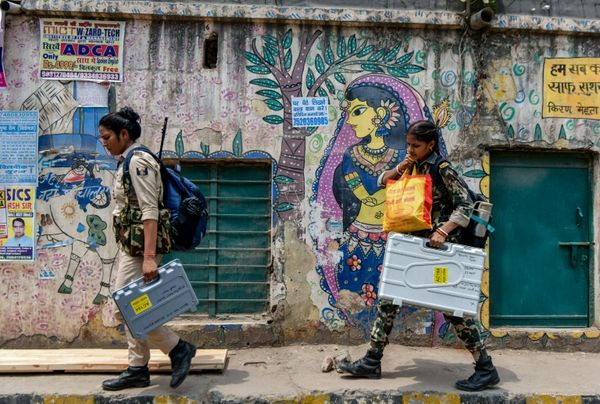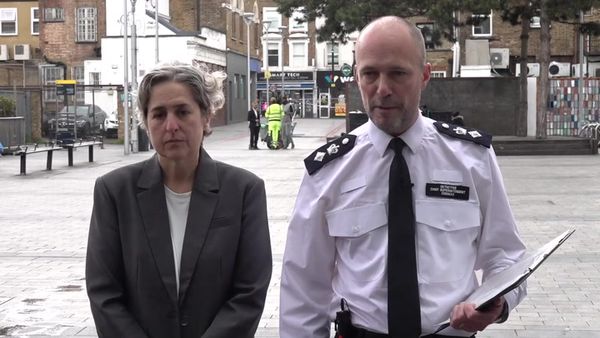
Fighting between the Myanmar military and the Arakan Army (AA) has escalated in the western state of Rakhine in recent days, putting thousands of mostly Muslim Rohingya who live in the area at increased risk.
Based on interviews with Rohingya activists who have spoken to witnesses in Buthidaung, there have been huge fires across the town in the last few days. They accuse the Arakan Army of being behind the arson campaign, but the AA has rejected the allegations saying the fires were started by the Myanmar military in air attacks.
What is clear is that thousands of Rohingya are fleeing for their lives and are increasingly unsafe, caught between the military, which seized power in a coup more than three years ago and in 2017 launched a brutal crackdown on the Rohingya that is now the subject of a genocide investigation, and the AA.
“As of now, people are still on the road looking for a safe place,” Nay San Lwin, the co-founder of the Free Rohingya Coalition advocacy group, told Al Jazeera. “There is no food or medicine at all. Most of them couldn’t carry their personal belongings.”
The Arakan Army is an ethnic armed group based in Rakhine state and is believed to have about 30,000 troops. The armed wing of the United League of Arakan, it represents the state’s majority Buddhist Rakhine and wants autonomy for the people of Arakan, the old name for the state. It was in an increasingly tentative ceasefire with the military until November last year.
Nay San Lwin claims the AA issued an ultimatum late last week, demanding that the Rohingya vacate Buthiduang by 10am on May 18, 2024. The AA had already attacked key locations where the Rohingya had sought shelter, including a school and a hospital, resulting in numerous injuries and fatalities, he said. The entire town reportedly “witnessed AA troops set fire to their houses”.
Rohingya sources report that since May 17, thousands of Rohingya refugees have sought safety in central Buthidaung, occupying any available space, including houses, government buildings, a hospital and schools. At least four different sources told Al Jazeera that fleeing Rohingya had been forced from their homes.
Al Jazeera was unable to independently verify the competing claims because the state’s internet and mobile phone networks have been largely shut off.

The Arakan Army denies being involved in the alleged arson campaign, but announced at the weekend that it had taken control of Buthidaung. On May 19, the AA’s Commander-In-Chief Twan Mrat Naing posted what appeared to be a warning on his X account.
“Attention R-Bengali diaspora activists and coterie,” he wrote, using the term “Bengali” that the Rohingya consider a slur. “The ppl of MM are fighting against a brutal military regime with great tribulations and sacrifices. Please stop selfish grumpiness and sabotaging, dragging the struggle into the wrong direction. It is time to abandon your misbegotten scheme of creating a separate islamic safe zone through foreign interventions, it is very unpatriotic.”
On Monday, the United League of Arakan blamed the Myanmar military for the fires. In a statement, it condemned the military for “prolonged aerial attacks on Buthidaung”, saying that “in reality, the SAC and its allies have destructed the town”, using the acronym for the State Administration Council as the military calls itself.
Trapped in rice fields
Regardless of who is responsible for the attacks, human rights groups are sounding the alarm: warning of the danger of another serious wave of ethnic and communal violence that could be even worse than in 2017.
That year, more than 750,000 Rohingya fled into neighbouring Bangladesh after the military launched a series of attacks on their villages after the Arakan Rohingya Salvation Army (ARSA), an armed group, attacked several police posts.
The United Nations has found that the military committed crimes against humanity and genocide in the crackdown, which is now the subject of an International Court of Justice genocide case.
While those who fled continue to live in sprawling refugee camps in Bangladesh, about 600,000 Rohingya remain in Myanmar, mostly in Rakhine state, and live under severe restrictions.
According to Fortify Rights, a human rights organisation working closely with Rohingya in both Bangladesh and Rakhine, the situation is extremely tense in a state that has a long history of communal violence.
Fortify Rights says while it is extremely difficult to verify who is responsible for the attacks, the reports from the past two nights have been harrowing.
“The AA and junta must refrain from causing harm or targeting civilian infrastructure including homes,” Sai Arkar, a human rights associate at Fortify Rights told Al Jazeera. “The area that has been burned does not seem to be a military target. [There are] reports of thousands of Rohingya being trapped in rice fields in the middle of the night, including children.”
The Special Advisory Council to Myanmar, known as the SAC-M, a group of former UN special rapporteurs monitoring the situation in Myanmar since the 2021 coup, also stressed the urgency of the situation.
“There are credible reports that Rohingya in Buthidaung have been targeted in attacks by the AA. There is a very real risk that these attacks could escalate further,” Yanghee Lee, the former UN special rapporteur on Myanmar and founder of SAC-M, told Al Jazeera.
Her concerns are supported by a Crisis Group report on May 10 that warned of the resurgence of inter-communal tensions in Rakhine. The think tank warned the military regime, which recently activated a long-dormant conscription law, would seek to foment inter-communal strife by forcing Rohingya to fight alongside them. Thousands had probably been conscripted, mostly forcibly, with the military playing on fears of the AA’s intentions but also dangling the promise of regular wages.
“The military has no qualms about using them as cannon fodder against the Arakan Army,” the report said.
While Lee stressed the military was the “main perpetrator of violence against civilians in Rakhine state”, she added that it was “extremely alarming that the AA now seems to be turning their guns on the Rohingya to complete the genocide undertaken by the same military it has long-opposed”. She urged the UN Human Rights Council to take immediate action to address the situation in Rakhine.
Satellite evidence
Given the complexity of the conflict in Rakhine, it is difficult to prove who is responsible for the arson attacks, but satellite evidence appears to corroborate the testimony of local witnesses.
Nathan Russer, a geospatial analyst at the Australian Strategic Policy Institute (ASPI), told Al Jazeera that based on satellite and other available evidence, the arson attacks were most likely to have been carried out by the AA.
“What we’re seeing is a widespread scale of arson attacks focused on [the] Buthidaung township in northern Rakhine State,” Russer said. “It appears that most of the villages and areas targeted in recent days are Rohingya settlements.”
Russer noted that an earlier wave of arson attacks in Buthidaung targeted largely ethnic Rakhine communities from April 11 to April 17.
Much of the arson in the last few days has targeted villages on the outskirts of Buthidaung, primarily to the south and southeast. He said that at least 35 villages in the area appear to have suffered significant fire damage.
“We’re seeing basically villages being burned down, an entire urban area being burned down, and surrounding fields and forests being largely untouched. This is quite diagnostic of an on-the-ground arson campaign, rather than a remote arson campaign.
“Putting those two facts together suggests very strongly that it’s the Arakan Army which has been responsible, corroborated by pretty unanimous eye-witness accounts from Buthidaung town itself, and seemingly from the surrounding areas.”
‘Burned to the ground’
Local Rohingya say the military’s air attacks took place in the afternoon on May 19, while the arson attacks reportedly began later that evening. Nay San Lwin stressed that the military’s troops had left the town at least three days before, on May 14, adding more credence to the allegations against the AA.
Wai Wai Nu, the director of the Women’s Peace Support Network who has close connections in Rakhine, also told Al Jazeera that she suspected the AA was behind the attacks.
“My community on the ground is telling me they feel like it is ‘the end of the world’ and that it is worse than in 2017,” Wai Wai Nu said. “I was also informed about cases of mass killings in different villages. They can be killed by the Arakan Army or the Myanmar junta any time.”
She said the Rohingya have long been living under an “apartheid regime” enforced by the Myanmar military, which has implemented discriminatory laws and policies, such as travel restrictions and other abuses. Now more than ever, she said, ethnic armed groups, and the broader pro-democracy movement, must work harder to protect vulnerable communities – especially the Rohingya.
They have “nowhere to go,” Wai Wai Nu said.
Over the last 24 hours, Nay San Lwin has spent his time fielding phone calls from family and others he knows in Buthidaung, trying to gather more details on the attacks. But it is a struggle given the network blackout.
“I spoke to six people yesterday… But the mobile network is extremely poor,” he said.
“There were no [Myanmar] military personnel nor ARSA present in the town. The Arakan Army troops suddenly came into the town and forced the people to leave their homes before setting the fire. Almost the entire town has been burned to the ground. Only a few houses remain intact.”





